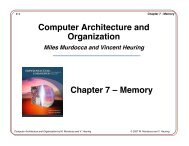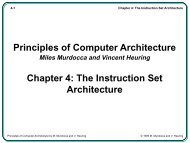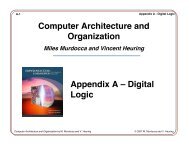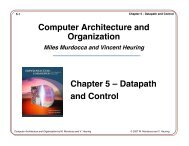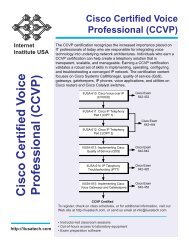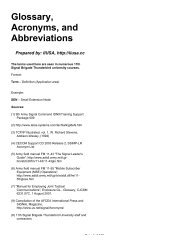COMPUTER ARCHITECTURE AND ORGANIZATION: An ... - IIUSA
COMPUTER ARCHITECTURE AND ORGANIZATION: An ... - IIUSA
COMPUTER ARCHITECTURE AND ORGANIZATION: An ... - IIUSA
You also want an ePaper? Increase the reach of your titles
YUMPU automatically turns print PDFs into web optimized ePapers that Google loves.
CHAPTER 3 PROBLEMS<br />
(3-1) Show the results of adding/subtracting the following pairs of six-bit (i.e. one sign bit and five<br />
data bits) two’s complement numbers and indicate whether or not overflow/underflow occurs for<br />
each case:<br />
0 1 0 1 1 0 1 0 1 0 1 1 1 1 1 1 1 1<br />
+ 0 0 1 0 0 1 + 1 0 0 1 0 1 + 0 0 0 1 1 1<br />
------------- ------------- -------------<br />
0 1 0 1 1 0 1 1 1 1 1 0 1 0 0 0 0 1<br />
- 0 1 1 1 1 1 - 1 0 0 1 0 1 - 0 1 1 1 0 1<br />
------------- ------------- -------------<br />
(3-2) (From Hamacher et al, 1990) Perform A×B and A/B on unsigned A=10101 and B=00101<br />
manually. (Just use pen and paper; do not show the serial multiplication or division menthods.)<br />
(3-3) Show how the unsigned serial multiplication method would compute M × Q where M = 10110<br />
and Q = 01101. M and Q are unsigned numbers. For each step, describe in words what is<br />
happening (shift left, shift right, add/subtract M or Q into product, set a bit, etc.), and show the<br />
product (or partial product) for that step. (Note: Q is the multiplier and M is the multiplicand.)<br />
Step # Product Action<br />
0 C=0 M=10110 Q=01101 Initial values _<br />
C A Q _<br />
(3-4) Use the Booth algorithm (not bit pair recoding) to multiply 0110 by 0110.<br />
(3-5) Use the modified Booth algorithm (that is, use bit pair recoding) to multiply signed numbers<br />
010101 (multiplicand) by 110110 (multiplier).<br />
(3-6) Use the Booth and bit-pair recoding techniques to multiply (-10 × -10 = 100) 10 .<br />
(3-7) Boolean expressions are shown below for the difference diffi = (xi – yi ) and borrow bi+1 outputs<br />
of a full subtractor. The subscripts denote the relative position of a full subtractor in a ripple-borrow<br />
subtractor:<br />
diffi = xiyibi + xiyibi + xiyibi + xiyibi bi+1 = xibi + xiyi + yibi We can factor the second equation and obtain:<br />
bi+1 = xiyi + bi (xi + yi )<br />
which can be rewritten as:<br />
bi+1 = Gi + Pib i<br />
where: Gi = xiyi and Pi = xi + yi .<br />
The G i and P i terms are referred to as generate and propagate functions, respectively, for the effect<br />
they have on the borrow. When G i = 1, a borrow is generated at stage i. When P i = 1, then a borrow is<br />
propagated through stage i if either x i is 0 or y i is 1. Create Boolean equations for b 0 , b 1 , b 2 , and b 3 for<br />
a borrow-lookahead subtractor in terms of P i and G i . Hint: Assume b 0 = 0.



